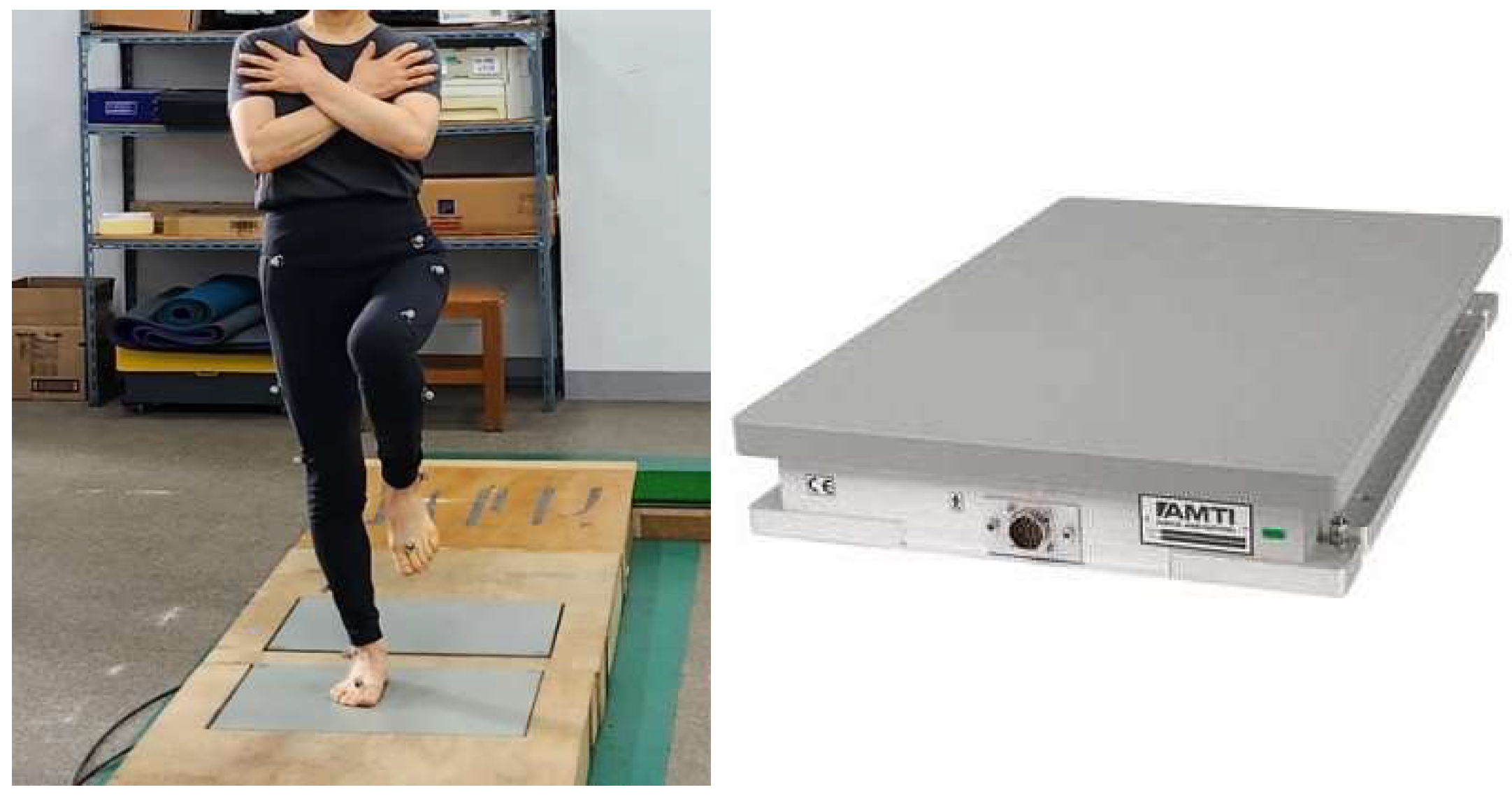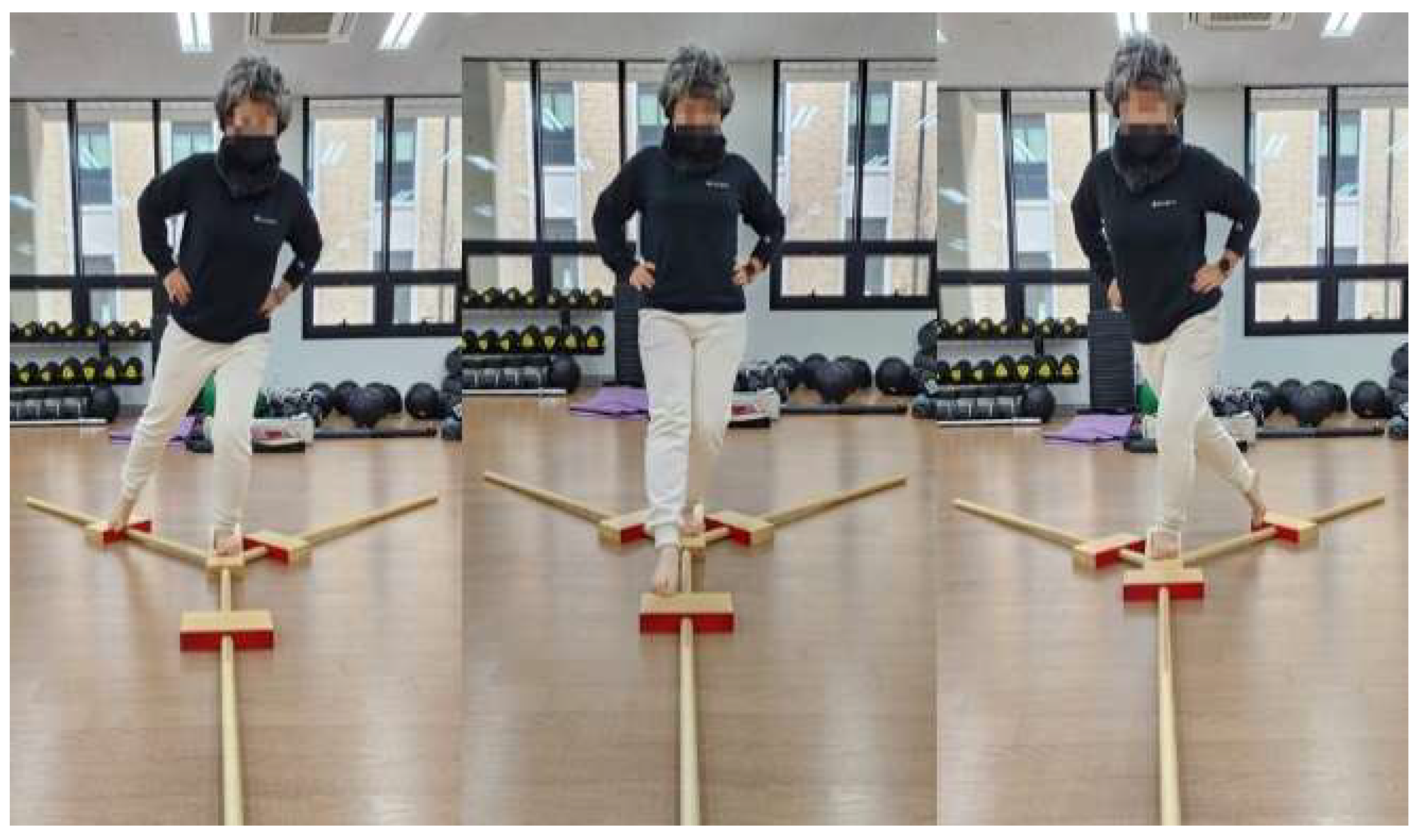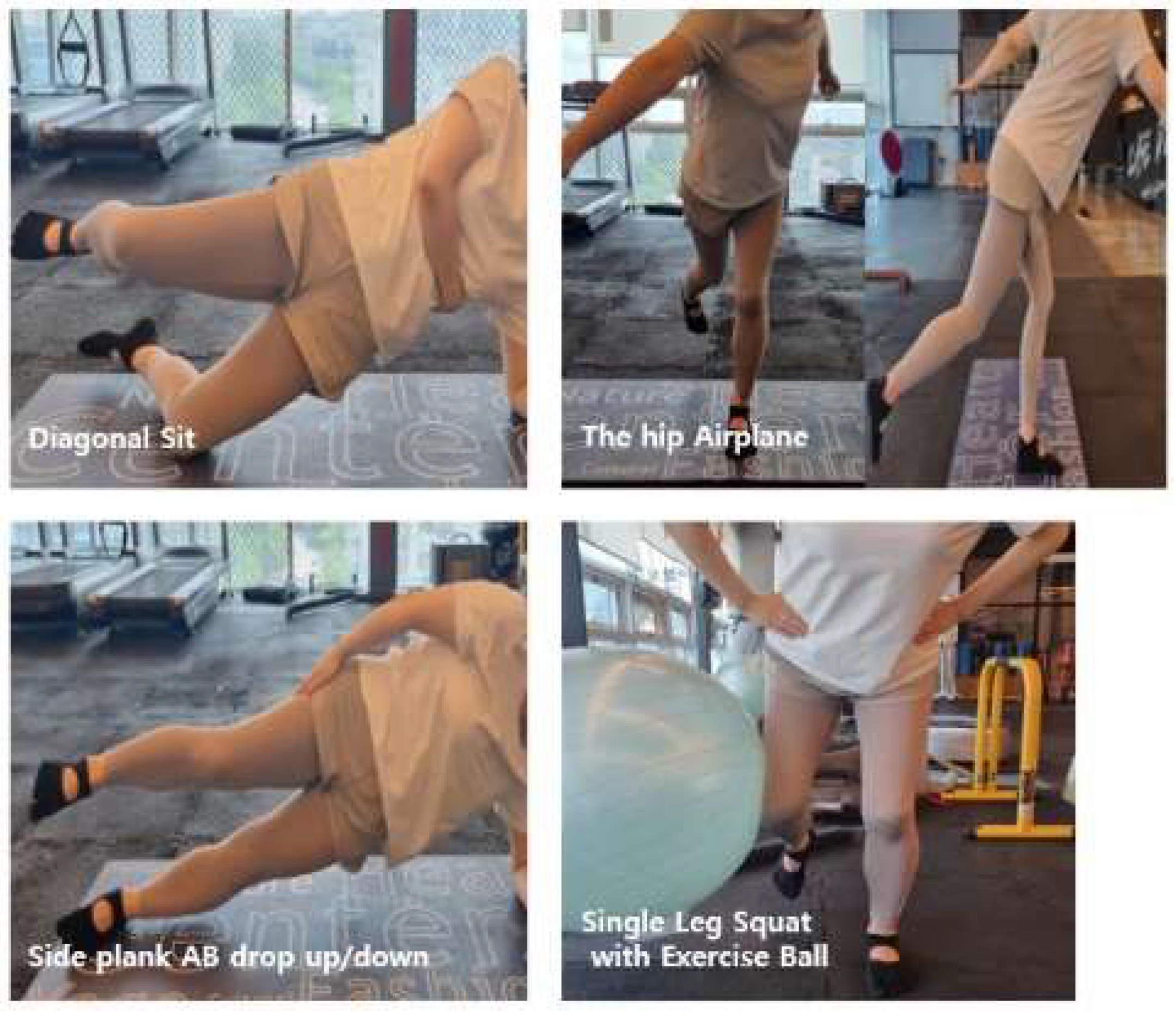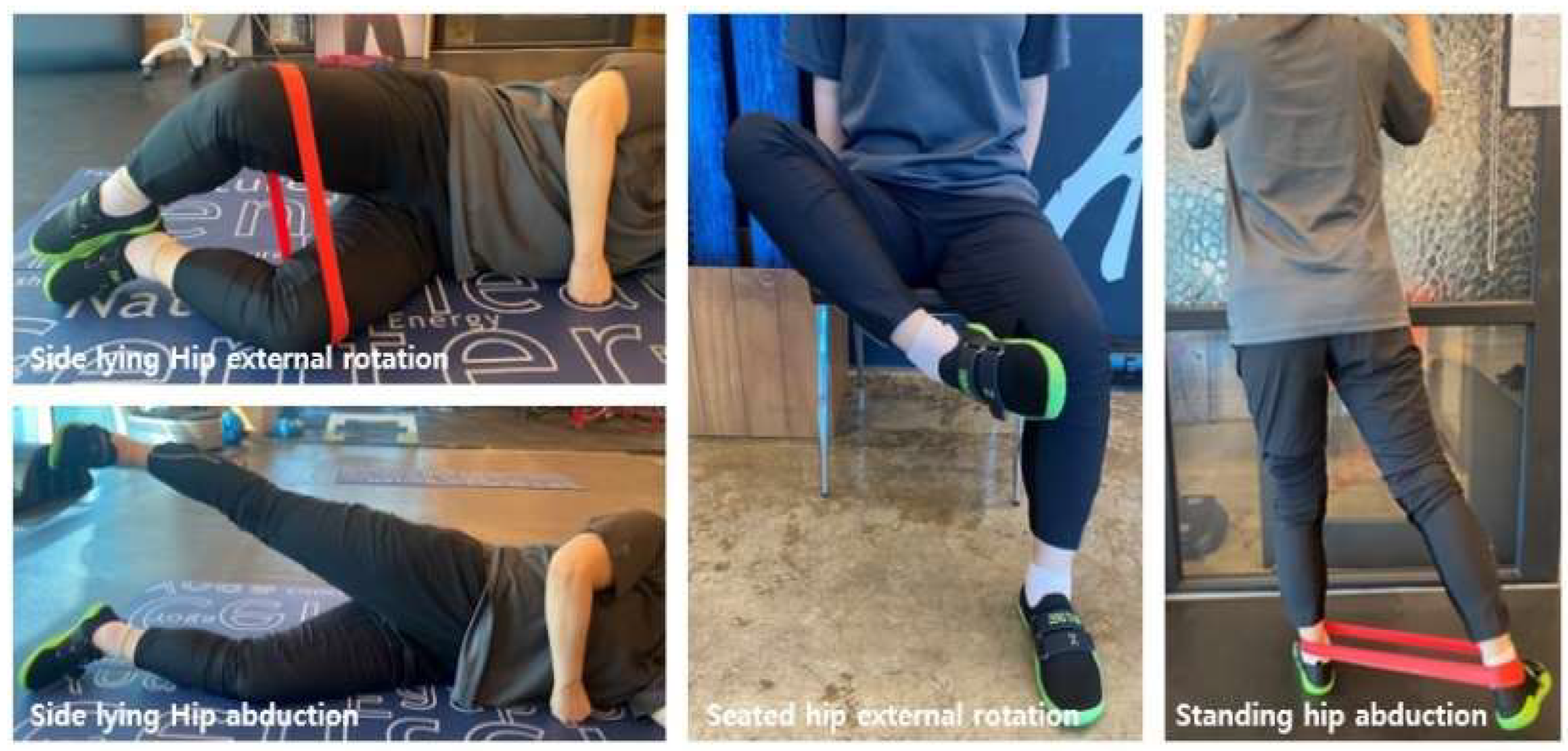Open Versus Closed Kinetic Chain: Exercise Effects on Center of Pressure and Y-Balance in Middle-Aged Women with Knee Osteoarthritis—A Randomized Controlled Trial
Abstract
1. Introduction
2. Materials and Methods
2.1. Participants
- (1)
- Women aged 50 to <65 years who were clinically diagnosed with unilateral knee osteoarthritis (KOA) and were prescribed exercise therapy by a physician.
- (2)
- Kellgren–Lawrence grade 1–2 out of a maximum of 4, assessed within the past 6 months [34].
- (3)
- Absence of other musculoskeletal diseases or relevant medical history.
- (1)
- History of knee surgery within the past year (due to risk of acute inflammation or severe pain).
- (2)
- History of serious cardiovascular disease (e.g., heart failure, myocardial infarction) or neurological, or psychiatric disorders.
- (3)
- Current severe pain or inflammation that would hinder walking or safe participation in exercise.
2.2. Experimental Procedures and Measurements
2.2.1. Static Balance
2.2.2. Dynamic Balance
2.3. Exercise Intervention
2.3.1. Closed-Kinetic-Chain (CKC) Exercise
2.3.2. Open-Kinetic-Chain (OKC) Exercise
2.4. Data Processing and Statistical Analysis
3. Results
3.1. COP Measurements
3.1.1. Comparison of Unaffected Limb COP Parameters Between the CKC and OKC Groups (Table 4)
| Variable | Group | Pre | Post | Within-Group (95% CI) | Between Groups (95% CI) | Group (p) | Time (p) | Interaction (p) | η2 |
|---|---|---|---|---|---|---|---|---|---|
| AP range | CKC | 6.01 ± 1.72 | 0.69 ± 0.07 ***† | +5.33 (3.97, 6.68) | −1.43 (−2.27, −0.59) | 0.537 | 0.000 | 0.001 | 0.537 |
| OKC | 4.02 ± 1.50 | 2.11 ± 1.10 ** | +1.91 (0.68, 3.14) | ||||||
| AP distance | CKC | 78.10 ± 20.20 | 42.64 ± 7.06 **† | +35.47 (18.33, 52.61) | −68.58 (−114.29, −22.86) | 0.023 | 0.569 | 0.002 | 0.464 |
| OKC | 62.60 ± 18.11 | 111.21 ± 59.34 * | −48.61 (−97.81, 0.59) | ||||||
| AP velocity | CKC | 2.60 ± 0.67 | 1.42 ± 0.24 **† | +1.18 (0.61, 1.75) | −2.29 (−3.81, −0.76) | 0.023 | 0.569 | 0.002 | 0.464 |
| OKC | 2.09 ± 0.60 | 3.71 ± 1.98 * | −1.62 (−3.26, 0.02) | ||||||
| AP RMS | CKC | 0.87 ± 0.19 | 0.09 ± 0.01 **† | 0.78 (0.64, 0.93) | −0.25 (−0.38, −0.11) | 0.473 | 0.000 | 0.000 | 0.594 |
| OKC | 0.71 ± 0.17 | 0.34 ± 0.18 ** | +0.38 (0.25, 0.50) | ||||||
| ML range | CKC | 3.99 ± 0.72 | 0.77 ± 0.09 **† | +3.22 (2.65, 3.78) | −1.74 (−2.64, −0.85) | 0.077 | 0.000 | 0.000 | 0.661 |
| OKC | 3.41 ± 0.76 | 2.52 ± 1.16 * | +0.89 (0.12, 1.67) | ||||||
| ML distance | CKC | 85.56 ± 14.04 | 46.97 ± 7.54 **† | +38.59 (27.77, 49.40) | −115.38 (−185.78, −44.97) | 0.002 | 0.247 | 0.002 | 0.455 |
| OKC | 86.01 ± 18.69 | 162.35 ± 91.50 * | −76.34 (−147.97, −4.70) | ||||||
| ML velocity | CKC | 2.85 ± 0.47 | 1.57 ± 0.25 **† | +1.29 (0.93, 1.65) | −3.85 (−6.19, −1.50) | 0.002 | 0.247 | 0.002 | 0.455 |
| OKC | 2.87 ± 0.62 | 5.41 ± 3.05 * | −2.54 (−4.93, −0.16) | ||||||
| ML RMS | CKC | 0.98 ± 0.16 | 0.08 ± 0.00 ***† | +0.90 (0.78, 1.03) | −0.18 (−0.32, −0.05) | 0.776 | 0.000 | 0.001 | 0.527 |
| OKC | 0.76 ± 0.26 | 0.26 ± 0.18 *** | +0.50 (0.32, 0.68) | ||||||
| Total distance | CKC | 128.29 ± 27.08 | 71.46 ± 11.69 **† | +56.83 (34.34, 79.32) | −148.28 (−241.80, −54.76) | 0.005 | 0.299 | 0.002 | 0.462 |
| OKC | 116.62 ± 28.42 | 219.74 ± 121.49 * | −103.12 (−199.96, −6.29) | ||||||
| Total velocity | CKC | 4.28 ± 0.90 | 2.38 ± 0.39 **† | +1.89 (1.14, 2.64) | −4.94 (−8.06, −1.83) | 0.005 | 0.299 | 0.002 | 0.462 |
| OKC | 3.89 ± 0.95 | 7.32 ± 4.05 * | −3.44 (−6.67, −0.21) |
3.1.2. Comparison of Affected Limb COP Parameters Between the CKC and OKC Groups (Table 5)
| Variable | Group | Pre | Post | Within-Group (95% CI) | Between Groups (95% CI) | Group (p) | Time (p) | Interaction (p) | η2 |
|---|---|---|---|---|---|---|---|---|---|
| AP range | CKC | 5.41 ± 2.52 | 0.70 ± 0.08 **† | +4.71 (2.75, 6.66) | −1.42 (−2.17, −0.67) | 0.650 | 0.000 | 0.028 | 0.266 |
| OKC | 4.50 ± 1.57 | 2.12 ± 0.98 ** | +2.38 (1.32, 3.45) | ||||||
| AP distance | CKC | 74.08 ± 18.91 | 43.33 ± 6.68 **† | +30.75 (14.24, 47.26) | −71.81 (−122.85, −20.76) | 0.017 | 0.490 | 0.005 | 0.393 |
| OKC | 67.07 ± 24.21 | 115.14 ± 66.30 * | −48.07 (−102.12, 5.98) | ||||||
| AP velocity | CKC | 2.47 ± 0.63 | 1.44 ± 0.22 **† | +1.03 (0.47, 1.58) | −2.39 (−4.10, −0.69) | 0.017 | 0.490 | 0.005 | 0.393 |
| OKC | 2.24 ± 0.81 | 3.84 ± 2.21 ** | −1.60 (−3.40, 0.20) | ||||||
| AP RMS | CKC | 0.91 ± 0.37 | 0.09 ± 0.01 **† | +0.82 (0.53, 1.11) | −0.25 (−0.38, −0.12) | 0.856 | 0.000 | 0.003 | 0.433 |
| OKC | 0.69 ± 0.15 | 0.34 ± 0.17 ** | +0.35 (0.24, 0.47) | ||||||
| ML range | CKC | 4.23 ± 1.43 | 0.75 ± 0.05 **† | +3.48 (2.38, 4.58) | −1.83 (−2.82, −0.83) | 0.238 | 0.000 | 0.000 | 0.552 |
| OKC | 3.31 ± 0.64 | 2.58 ± 1.30 | +0.73 (−0.18, 1.64) | ||||||
| ML distance | CKC | 86.04 ± 8.90 | 47.16 ± 7.29 **† | +38.88 (30.35, 47.42) | −119.03 (−195.13, −42.92) | 0.003 | 0.219 | 0.003 | 0.440 |
| OKC | 83.29 ± 19.58 | 166.18 ± 98.92 * | −82.89 (−161.70, −4.09) | ||||||
| ML velocity | CKC | 2.87 ± 0.30 | 1.57 ± 0.24 **† | +1.30 (1.01, 1.58) | −3.97 (−6.50, −1.43) | 0.003 | 0.219 | 0.003 | 0.440 |
| OKC | 2.78 ± 0.65 | 5.54 ± 3.30 * | −2.76 (−5.39, −0.14) | ||||||
| ML RMS | CKC | 0.90 ± 0.20 | 0.08 ± 0.00 **† | +0.82 (0.67, 0.97) | −0.17 (−0.27, −0.87) | 0.417 | 0.000 | 0.091 | 0.168 |
| OKC | 0.87 ± 0.34 | 0.25 ± 0.13 ** | +0.62 (0.40, 0.83) | ||||||
| Total distance | CKC | 124.96 ± 21.48 | 72.11 ± 11.17 **† | +52.85 (33.20, 72.49) | −154.14 (−256.58, −51.70) | 0.005 | 0.255 | 0.003 | 0.424 |
| OKC | 118.00 ± 32.52 | 226.25 ± 133.12 * | −108.26 (−214.66, −1.86) | ||||||
| Total velocity | CKC | 4.17 ± 0.72 | 2.40 ± 0.37 **† | +1.76 (1.11, 2.42) | −5.14 (−8.55, −1.72) | 0.005 | 0.255 | 0.003 | 0.424 |
| OKC | 3.93 ± 1.08 | 7.54 ± 4.44 * | −3.61 (−7.16, −0.06) |
3.2. Dynamic Balance
Single-Leg Balance and Functional Movement (Table 6)
| Variable | Group | Pre | Post | Within-Group (95% CI) | Between Groups (95% CI) | Group (p) | Time (p) | Interaction (p) | η2 |
|---|---|---|---|---|---|---|---|---|---|
| Affected Limb | CKC | 87.07 ± 8.46 | 100.3 ± 6.23 ***† | −12.62 (−17.72, −7.53) | +16.07 (5.84, 26.31) | 0.073 | 0.005 | 0.000 | 0.587 |
| OKC | 87.67 ± 10.18 | 87.29 ± 10.82 | 2.31 (−2.80, 7.42) | ||||||
| Unaffected Limb | CKC | 88.60 ± 7.52 | 102.2 ± 3.54 ***† | −12.58 (−17.32, −7.85) | +12.36 (3.65, 21.08) | 0.162 | 0.001 | 0.000 | 0.529 |
| OKC | 87.46 ± 11.75 | 85.15 ± 13.69 | +0.38 (−4.28, 5.03) |
4. Discussion
5. Conclusions
Author Contributions
Funding
Institutional Review Board Statement
Informed Consent Statement
Data Availability Statement
Conflicts of Interest
Abbreviations
| KOA | Knee osteoarthritis. |
| CKC | Closed-kinetic-chain exercise. |
| OKC | Open-kinetic-chain exercise. |
| COP | Center of pressure. |
| AP | Anterior–posterior. |
| ML | Medial–lateral. |
| RMS | Root mean square. |
| GRF | Ground reaction forces. |
| YBT | Y-balance test. |
References
- Fransen, M.; McConnell, S.; Harmer, A.R.; Van der Esch, M.; Simic, M.; Bennell, K.L. Exercise for osteoarthritis of the knee. Cochrane Database Syst. Rev. 2015, 1, CD004376. [Google Scholar] [CrossRef]
- Waer, F.B.; Laatar, R.; Jouira, G.; Srihi, S.; Rebai, H.; Sahli, S. Functional and cognitive responses to caffeine intake in middle-aged women are dose depending. Behav. Brain Res. 2021, 397, 112956. [Google Scholar] [CrossRef]
- Middlekauff, M.; Lee, W.; Egger, M.J.; Nygaard, I.E.; Shaw, J.M. Physical activity patterns in healthy middle-aged women. J. Women Aging 2016, 20, 469–476. [Google Scholar] [CrossRef] [PubMed]
- Suh, D.H.; Han, K.D.; Hong, J.Y.; Park, J.H.; Bae, J.H.; Moon, Y.W.; Kim, J.G. Body composition is more closely related to the development of knee osteoarthritis in women than men: A cross-sectional study using the Fifth Korea National Health and Nutrition Examination Survey (KNHANES V-1, 2). Osteoarthr. Cartil. 2016, 24, 605–611. [Google Scholar] [CrossRef]
- Srikanth, V.K.; Fryer, J.L.; Zhai, G.; Winzenberg, T.M.; Hosmer, D.; Jones, G. A meta-analysis of sex differences prevalence, incidence and severity of osteoarthritis. Osteoarthr. Cartil. 2005, 13, 769–781. [Google Scholar] [CrossRef]
- Nolan, M.; Nitz, J.; Choy, N.L.; Illing, S. Age-related changes in musculoskeletal function, balance and mobility measures in men aged 30–80 years. Aging Male 2010, 13, 194–201. [Google Scholar] [CrossRef] [PubMed]
- Zhang, Y.; Jordan, J.M. Epidemiology of osteoarthritis. Clin. Geriatr. Med. 2010, 26, 355–369. [Google Scholar] [CrossRef]
- Lyytinen, T.; Liikavainio, T.; Bragge, T.; Hakkarainen, M.; Karjalainen, P.A.; Arokoski, J.P. Postural control and thigh muscle activity in men with knee osteoarthritis. J. Electromyogr. Kinesiol. 2010, 20, 1066–1074. [Google Scholar] [CrossRef] [PubMed]
- Jan, M.H.; Lin, C.H.; Lin, Y.F.; Lin, J.J.; Lin, D.H. Effects of weight-bearing versus nonweight-bearing exercise on function, walking speed, and position sense in participants with knee osteoarthritis: A randomized controlled trial. Arch. Phys. Med. Rehabil. 2009, 90, 897–904. [Google Scholar] [CrossRef]
- Ikutomo, H.; Nagai, K.; Tagomori, K.; Miura, N.; Nakagawa, N.; Masuhara, K. Incidence and risk factors for falls in women with end-stage hip osteoarthritis. J. Geriatr. Phys. Ther. 2019, 42, 161–166. [Google Scholar] [CrossRef]
- Rim, Y.A.; Nam, Y.; Ju, J.H. The Role of Chondrocyte Hypertrophy and Senescence in Osteoarthritis Initiation and Progression. Int. J. Mol. Sci. 2020, 21, 2358. [Google Scholar] [CrossRef]
- Chang, A.; Hayes, K.; Dunlop, D.; Song, J.; Hurwitz, D.; Cahue, S.; Sharma, L. Hip abduction moment and protection against medial tibiofemoral osteoarthritis progression. Arthritis Rheum. 2005, 52, 3515–3519. [Google Scholar] [CrossRef]
- Bhatt, N.G.; Sheth, M.S.; Vyas, N.J. Correlation of fear avoidance beliefs with pain and physical function in subjects with osteoarthritis of knee (OA knee). Int. J. Ther. Rehabil. Res. 2015, 4, 117–121. [Google Scholar] [CrossRef]
- Cho, H.J.; Chang, C.B.; Kim, K.W.; Park, J.H.; Yoo, J.H.; Koh, I.J.; Kim, T.K. Gender and prevalence of knee osteoarthritis types in elderly Koreans. J. Arthroplast. 2011, 26, 994–999. [Google Scholar] [CrossRef] [PubMed]
- Andriacchi, T.P.; Favre, J.; Erhart-Hledik, J.C.; Chu, C.R. A systems view of risk factors for knee osteoarthritis reveals insights into the pathogenesis of the disease. Ann. Biomed. Eng. 2015, 43, 376–387. [Google Scholar] [CrossRef]
- Hall, M.; Bennell, K.L.; Wrigley, T.V.; Metcalf, B.R.; Campbell, P.K.; Kasza, J.; Hinman, R.S. The knee adduction moment and knee osteoarthritis symptoms: Relationships according to radiographic disease severity. Osteoarthr. Cartil. 2017, 25, 34–41. [Google Scholar] [CrossRef]
- Karimi, M.T.; Sharifmoradi, K. Static and local dynamic stability of subjects with knee joint osteoarthritis. Proc. Inst. Mech. Eng. Part H 2022, 236, 1100–1105. [Google Scholar] [CrossRef]
- Sabashi, K.; Ishida, T.; Matsumoto, H.; Mikami, K.; Chiba, T.; Yamanaka, M.; Aoki, Y.; Tohyama, H. Dynamic postural control correlates with activities of daily living and quality of life in patients with knee osteoarthritis. BMC Musculoskelet. Disord. 2021, 22, 287. [Google Scholar] [CrossRef] [PubMed]
- Wang, J.; Hu, Q.; Wu, C.; Li, S.; Deng, Q.; Tang, R.; Li, K.; Nie, Y.; Shen, B. Gait asymmetry variation in kinematics, kinetics, and muscle force along with the severity levels of knee osteoarthritis. Orthop. Surg. 2023, 15, 1384–1391. [Google Scholar] [CrossRef] [PubMed]
- Bennell, K.L.; Wrigley, T.V.; Hunt, M.A.; Lim, B.W.; Hinman, R.S. Update on the role of muscle in the genesis and management of knee osteoarthritis. Rheum. Dis. Clin. 2013, 39, 145–176. [Google Scholar] [CrossRef]
- Tuna, S.; Balcı, N.; Özçakar, L. The relationship between femoral cartilage thickness and muscle strength in knee osteoarthritis. Clin. Rheumatol. 2016, 35, 2073–2077. [Google Scholar] [CrossRef] [PubMed]
- van der Esch, M.; Holla, J.F.; van der Leeden, M.; Knol, D.L.; Lems, W.F.; Roorda, L.D.; Dekker, J. Decrease of muscle strength is associated with increase of activity limitations in early knee osteoarthritis: 3-year results from the cohort hip and cohort knee study. Arch. Phys. Med. Rehabil. 2014, 95, 1962–1968. [Google Scholar] [CrossRef]
- Neelapala, Y.R.; Bhagat, M.; Shah, P. Hip muscle strengthening for knee osteoarthritis: A systematic review of literature. J. Geriatr. Phys. Ther. 2020, 43, 89–98. [Google Scholar] [CrossRef] [PubMed]
- Duscha, B.D.; Cipriani, D.J.; Roberts, C.P. A Review of Open vs. Closed Kinetic Chain Exercise for Lower Extremity Rehabilitation. Clin. Exerc. Physiol. 1999, 1, 73–82. [Google Scholar]
- Fu, F.H.; Woo, S.L.; Irrgang, J.J. Current concepts for rehabilitation following anterior cruciate ligament reconstruction. J. Orthop. Sports Phys. Ther. 1992, 15, 270–278. [Google Scholar] [CrossRef]
- Atha, J. Strengthening muscle. Exerc. Sport Sci. Rev. 1981, 9, 1–74. [Google Scholar] [CrossRef]
- Palmitier, R.A.; An, K.N.; Scott, S.G.; Chao, E.Y. Kinetic chain exercise in knee rehabilitation. Sports Med. 1991, 11, 402–413. [Google Scholar] [CrossRef]
- Chen, S.; Chang, W.D.; Wu, J.Y.; Fong, Y.C. Electromyographic analysis of hip and knee muscles during specific exercise movements in females with patellofemoral pain syndrome: An observational study. Medicine 2018, 97, e11424. [Google Scholar] [CrossRef]
- Boren, K.; Conrey, C.; Le Coguic, J.; Paprocki, L.; Voight, M.; Robinson, T.K. Electromyographic analysis of gluteus medius and gluteus maximus during rehabilitation exercises. Int. J. Sports Phys. Ther. 2011, 6, 206–223. [Google Scholar] [PubMed]
- Scoppa, F.; Capra, R.; Gallamini, M.; Shiffer, R. Clinical stabilometry standardization: Basic definitions–acquisition interval–sampling frequency. Gait Posture 2013, 37, 290–292. [Google Scholar] [CrossRef]
- Thomas, D.T.; R, S.; Prabhakar, A.J.; Dineshbhai, P.V.; Eapen, C. Hip abductor strengthening in patients diagnosed with knee osteoarthritis—A systematic review and meta-analysis. BMC Musculoskelet. Disord. 2022, 23, 622. [Google Scholar] [CrossRef]
- Plisky, P.J.; Gorman, P.P.; Butler, R.J.; Kiesel, K.B.; Underwood, F.B.; Elkins, B. The reliability of an instrumented device for measuring components of the star excursion balance test. N. Am. J. Sports Phys. Ther. 2009, 4, 92–99. [Google Scholar] [PubMed] [PubMed Central]
- Wilson, B.R.; Robertson, K.E.; Burnham, J.M.; Yonz, M.C.; Ireland, M.L.; Noehren, B. The Relationship Between Hip Strength and the Y Balance Test. J. Sport Rehabil. 2018, 27, 445–450. [Google Scholar] [CrossRef] [PubMed]
- Kohn, M.D.; Sassoon, A.A.; Fernando, N.D. Classifications in brief: Kellgren-Lawrence classification of osteoarthritis. Clin. Orthop. Relat. Res. 2016, 474, 1886–1893. [Google Scholar] [CrossRef] [PubMed]
- Beattie, P.; Issacson, K.; Riddle, D.L.; Rothstein, J.M. Validity of derived measurements of leg-length differences obtained by use of a tape measure. Phys. Ther. 1990, 70, 150–157. [Google Scholar] [CrossRef] [PubMed]
- Son, S.M.; Kang, K.W. Effect of action observation training using y-balance on balance capability in young adults. J. Korean Phys. Ther. 2020, 32, 65–69. [Google Scholar] [CrossRef]
- Shaffer, S.W.; Teyhen, D.S.; Lorenson, C.L.; Warren, R.L.; Koreerat, C.M.; Straseske, C.A.; Childs, J.D. Y-balance test: A reliability study involving multiple raters. Mil. Med. 2013, 178, 1264–1270. [Google Scholar] [CrossRef]
- Liebenson, D.C. Hip muscle training. J. Bodyw. Mov. Ther. 2011, 15, 251–252. [Google Scholar] [CrossRef]
- Liebenson, C.; Sato, K. The low diagonal (oblique) sit exercise. J. Bodyw. Mov. Ther. 2014, 18, 643–645. [Google Scholar] [CrossRef]
- Liebenson, C. Training the hip: A progressive approach. J. Bodyw. Mov. Ther. 2013, 17, 266–268. [Google Scholar] [CrossRef]
- Barton, C.J.; Kennedy, A.; Twycross-Lewis, R.; Woledge, R.; Malliaras, P.; Morrissey, D. Gluteal muscle activation during the isometric phase of squatting exercises with and without a Swiss ball. Phys. Ther. Sport 2014, 15, 39–46. [Google Scholar] [CrossRef]
- Dolak, K.L.; Silkman, C.; Medina McKeon, J.; Hosey, R.G.; Lattermann, C.; Uhl, T.L. Hip strengthening prior to functional exercises reduces pain sooner than quadriceps strengthening in females with patellofemoral pain syndrome: A randomized clinical trial. J. Orthop. Sports Phys. Ther. 2011, 41, 560–570. [Google Scholar] [CrossRef]
- Bejek, Z.; Paróczai, R.; Illyés, Á.; Kocsis, L.; Kiss, R.M. Gait parameters of patients with osteoarthritis of the knee joint. Facta Univ. Ser. Phys. Educ. Sport 2006, 4, 9–16. [Google Scholar]
- Hinman, R.S.; Hunt, M.A.; Creaby, M.W.; Wrigley, T.V.; McManus, F.J.; Bennell, K.L. Hip muscle weakness in individuals with medial knee osteoarthritis. Arthritis Care Res. 2010, 62, 1190–1193. [Google Scholar] [CrossRef] [PubMed]
- Mündermann, A.; Dyrby, C.O.; Andriacchi, T.P. Secondary gait changes in patients with medial compartment knee osteoarthritis: Increased load at the ankle, knee, and hip during walking. Arthritis Rheum. 2005, 52, 2835–2844. [Google Scholar] [CrossRef]
- Adeel, M.; Lin, B.S.; Chaudhary, M.A.; Chen, H.C.; Peng, C.W. Effects of Strengthening Exercises on Human Kinetic Chains Based on a Systematic Review. J. Funct. Morphol. Kinesiol. 2024, 9, 22. [Google Scholar] [CrossRef] [PubMed]
- Ferreira, L.G.; Genebra, C.V.; Maciel, N.M.; Arca, E.A.; Fiorelli, A.; Vitta, A.D. Multisensory and closed kinetic chain exercises on the functional capacity and balance in elderly women: Blinded randomized clinical trial. Fisioter. Mov. 2017, 30, 259–266. [Google Scholar] [CrossRef]




| OKC (n = 11) | CKC (n = 11) | |
|---|---|---|
| Age (year) | 62.1 ± 2.52 | 63.6 ± 1.80 |
| Weight (kg) | 59.5 ± 7.40 | 62.3 ± 6.45 |
| Height (cm) | 157.36 ± 6.36 | 160.86 ± 5.94 |
| BMI (kg/m2) | 24.04 ± 2.43 | 24.10 ± 2.62 |
| CKC Group | Exercise |
|---|---|
| Warm-up (Mobility for 10 min) | - Ankle and hip mobility |
| Main exercise (for 40 min/3 set) | - The low diagonal oblique sit - Side plank AB drop up/down - Single-leg squat with isometric hip abduction (gym ball) - The hip airplane |
| Cool-down (stretching for 10 min) | - Ankle and hip stretching |
| OKC Group | Exercise |
|---|---|
| Warm-up (Mobility for 10 min) | - Ankle and hip mobility |
| Main exercise (for 40 min/4 set) | - Side-lying hip abduction - Side-lying hip external rotation - Seated hip external rotation - Standing hip abduction |
| Cool-down (stretching for 10 min) | - Ankle and hip stretching |
Disclaimer/Publisher’s Note: The statements, opinions and data contained in all publications are solely those of the individual author(s) and contributor(s) and not of MDPI and/or the editor(s). MDPI and/or the editor(s) disclaim responsibility for any injury to people or property resulting from any ideas, methods, instructions or products referred to in the content. |
© 2025 by the authors. Licensee MDPI, Basel, Switzerland. This article is an open access article distributed under the terms and conditions of the Creative Commons Attribution (CC BY) license (https://creativecommons.org/licenses/by/4.0/).
Share and Cite
Kang, J.; Lee, J.Y.; Park, I.B. Open Versus Closed Kinetic Chain: Exercise Effects on Center of Pressure and Y-Balance in Middle-Aged Women with Knee Osteoarthritis—A Randomized Controlled Trial. Healthcare 2025, 13, 2173. https://doi.org/10.3390/healthcare13172173
Kang J, Lee JY, Park IB. Open Versus Closed Kinetic Chain: Exercise Effects on Center of Pressure and Y-Balance in Middle-Aged Women with Knee Osteoarthritis—A Randomized Controlled Trial. Healthcare. 2025; 13(17):2173. https://doi.org/10.3390/healthcare13172173
Chicago/Turabian StyleKang, June, Ja Yeon Lee, and Il Bong Park. 2025. "Open Versus Closed Kinetic Chain: Exercise Effects on Center of Pressure and Y-Balance in Middle-Aged Women with Knee Osteoarthritis—A Randomized Controlled Trial" Healthcare 13, no. 17: 2173. https://doi.org/10.3390/healthcare13172173
APA StyleKang, J., Lee, J. Y., & Park, I. B. (2025). Open Versus Closed Kinetic Chain: Exercise Effects on Center of Pressure and Y-Balance in Middle-Aged Women with Knee Osteoarthritis—A Randomized Controlled Trial. Healthcare, 13(17), 2173. https://doi.org/10.3390/healthcare13172173





